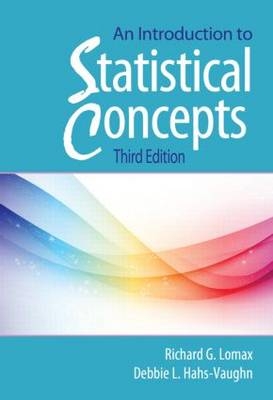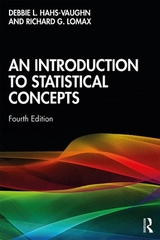
An Introduction to Statistical Concepts
Routledge Academic (Verlag)
978-0-415-88005-3 (ISBN)
- Titel erscheint in neuer Auflage
- Artikel merken
In addition to updating throughout, the new edition features:
New co-author, Debbie L. Hahs-Vaughn, the 2007 recipient of the University of Central Florida's College of Education Excellence in Graduate Teaching Award.
A new chapter on logistic regression models for today's more complex methodologies.
More on computing confidence intervals and conducting power analyses using G*Power.
Many more SPSS screenshots to assist with understanding how to navigate SPSS and annotated SPSS output to assist in the interpretation of results.
Extended sections on how to write-up statistical results in APA format.
New learning tools including chapter-opening vignettes, outlines, and a list of key concepts, many more examples, tables, and figures, boxes, and chapter summaries.
More tables of assumptions and the effects of their violation including how to test them in SPSS.
33% new conceptual, computational, and all new interpretative problems.
A website that features PowerPoint slides, answers to the even-numbered problems, and test items for instructors, and for students the chapter outlines, key concepts, and datasets that can be used in SPSS and other packages, and more.
Each chapter begins with an outline, a list of key concepts, and a vignette related to those concepts. Realistic examples from education and the behavioral sciences illustrate those concepts. Each example examines the procedures and assumptions and provides instructions for how to run SPSS, including annotated output, and tips to develop an APA style write-up. Useful tables of assumptions and the effects of their violation are included, along with how to test assumptions in SPSS. 'Stop and Think' boxes provide helpful tips for better understanding the concepts. Each chapter includes computational, conceptual, and interpretive problems. The data sets used in the examples and problems are provided on the web. Answers to the odd-numbered problems are given in the book.
The first five chapters review descriptive statistics including ways of representing data graphically, statistical measures, the normal distribution, and probability and sampling. The remainder of the text covers inferential statistics involving means, proportions, variances, and correlations, basic and advanced analysis of variance and regression models. Topics not dealt with in other texts such as robust methods, multiple comparison and nonparametric procedures, and advanced ANOVA and multiple and logistic regression models are also reviewed.
Intended for one- or two-semester courses in statistics taught in education and/or the behavioral sciences at the graduate and/or advanced undergraduate level, knowledge of statistics is not a prerequisite. A rudimentary knowledge of algebra is required.
Richard G. Lomax is a Professor in the School of Educational Policy and Leadership at The Ohio State University. He received his Ph.D. in Educational Research Methodology from the University of Pittsburgh. His research focuses on models of literacy acquisition, multivariate statistics, and assessment. He has twice served as a Fulbright Scholar and is a Fellow of the American Educational Research Association. Debbie L. Hahs-Vaughn is an Associate Professor in the College of Education at the University of Central Florida. She received her Ph.D. in Educational Research from the University of Alabama. Her research focuses on methodological and substantive research using complex survey data, program evaluation, and practitioner use of research to inform their practice. Dr. Hahs-Vaughn was the recipient of the 2007 College of Education Excellence in Graduate Teaching Award, 2009 College of Education Distinguished Researcher Award, 2009 Teaching Incentive Program Award, and 2009 Research Incentive Award. She is currently the Executive Editor of the Measurement, Statistics, and Research Design section of the Journal of Experimental Education.
1. Introduction. 2. Data Representation. 3. Univariate Population Parameters and Sample Statistics. 4. The Normal Distribution and Standard Scores. 5. Introduction to Probability and Sample Statistics. 6. Introduction to Hypothesis Testing: Inferences About a Single Mean. 7. Inferences About the Difference Between Two Means. 8. Inferences About Proportions. 9. Inferences About Variances. 10. Bivariate Measures of Association. 11. One-Factor Analysis of Variance - Fixed-Effects Model. 12. Multiple Comparison Procedures. 13. Factorial Analysis of Variance - Fixed-Effects Model. 14. Introduction to Analysis of Covariance: The One-Factor Fixed-Effects Model With a Single Covariate. 15. Random- and Mixed-Effects Analysis of Variance Models. 16. Hierarchical and Randomized Block Analysis of Variance Models. 17. Simple Linear Regression. 18. Multiple Regression. 19. Logistic Regression. Appendix Tables.
| Verlagsort | London |
|---|---|
| Sprache | englisch |
| Maße | 178 x 254 mm |
| Gewicht | 1633 g |
| Themenwelt | Geisteswissenschaften ► Psychologie |
| Mathematik / Informatik ► Mathematik ► Statistik | |
| ISBN-10 | 0-415-88005-X / 041588005X |
| ISBN-13 | 978-0-415-88005-3 / 9780415880053 |
| Zustand | Neuware |
| Informationen gemäß Produktsicherheitsverordnung (GPSR) | |
| Haben Sie eine Frage zum Produkt? |
aus dem Bereich



